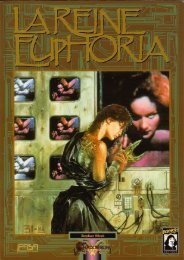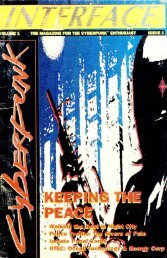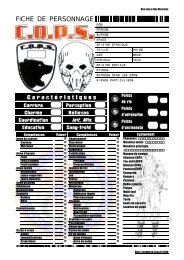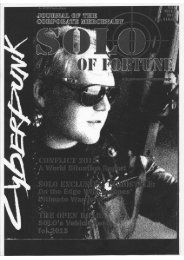[Shadowrun][JDR-ENG].. - Index of - Free
[Shadowrun][JDR-ENG].. - Index of - Free
[Shadowrun][JDR-ENG].. - Index of - Free
- No tags were found...
You also want an ePaper? Increase the reach of your titles
YUMPU automatically turns print PDFs into web optimized ePapers that Google loves.
LIFE ON THE EDGEcompetence and pr<strong>of</strong>essionalism. If you need something more extensivedone and you can make the right connections, “black clinics” withcorp-exile surgeons and all kinds <strong>of</strong> stolen and experimental technologiesand techniques can provide whatever enhancements you desire,legal or not.Savvy shadowrunners don’t take chances with these matters—as soon as they’ve got the cred to do it, most <strong>of</strong> them sign up for acontract with one <strong>of</strong> the “armed response” providers like DocWagonor CrashCart. These services will do everything from swooping in tosnatch your injured body out <strong>of</strong> a firefight to bringing you back fromthe other side <strong>of</strong> flatlined. Yeah, that little biomonitor and contractare expensive, but when you think about it, what do you own that’smore valuable than your life? Just one thing to note, though: if you’regoing to get yourself shot up, don’t do it on megacorp property—theseoutfits won’t cross extraterritorial boundaries without permission, soyou’ll be out <strong>of</strong> luck.Welcome to the MACHINEBack in the latter part <strong>of</strong> the last century, futurists and cyber-punditswere all excited about the coming <strong>of</strong> “ubiquitous computing”—thetotal integration <strong>of</strong> computer technology with everyday life. They wereright, but they didn’t know the half <strong>of</strong> it. While your average 2070scitizen probably wouldn’t think <strong>of</strong> it in those terms, computers and theMatrix are ubiquitous nowadays—in fact, you’d have to try pretty hardto get away from them. Here are a few everyday-life examples—you cancheck out The Wireless World, p. 216, for the full lowdown on usingthe Matrix for fun and pr<strong>of</strong>it.Matrix 2.0The times, they are a-changin’, but people are nothing if not adaptable.Even before Crash 2.0 took down the Matrix and caused widespreadchaos on multiple fronts, the seeds <strong>of</strong> wireless network connectivitywere already sown. By 2070, the new wireless Matrix is mostly in place,and the whole Matrix model has shifted from wired virtual reality towireless augmented reality. That’s not to say that you can’t still go forthe full-immersion experience, but AR has proven itself to be morepractical in most situations. Most people by now have embraced thenew technology, to the point where even the poorest sprawl denizensare likely to have commlinks that connect them to the Matrix on aconstant basis. What this means is that everybody’s wired (or, rather,wireless) and everybody’s connected. For most people, the questionisn’t whether to be connected, but how much.The Network is the CONSuMEREvery time you go out to the mall or the Stuffer Shack or thatnew club downtown, you’re surrounded by computer networks.Everybody’s heard <strong>of</strong> LANs and WANs, but 2070s society brings anew one: PANs, or Personal Area Networks. People don’t just belongto networks these days—they are networks. All hooked together bya commlink (a combination cellphone, PDA, wallet, and networkrouter), PANs are accessed and controlled by a wide array <strong>of</strong> usefuldevices, including goggles, contacts, or cybereyes that let you perceivethe sights <strong>of</strong> augmented reality; headphones or cyberears that giveyou the sounds; gloves for the touch; clothing that regulates yourtemperature and lets you change its color with a thought; simsensemodules that let you experience sensations, emotions, and evenothers’ senses; weapons and peripherals tied directly into your consciouscontrol; and a whole lot more. It’s called a “mesh network,”and it means that all your goodies talk to each other seamlessly, keep-ing each other up to date with status reports and working together toenhance your computing experience.Sharing the LoveAll this PAN stuff is wiz, but just like the dinosaur days <strong>of</strong> the Internet,networking isn’t much fun if you can’t share it. When you open upyour PAN to the outside world (or whatever part <strong>of</strong> it you chooseto allow in), you open the door to a myriad <strong>of</strong> interactions. Headingdown to the mall to check out the latest gear, you can subscribe yourPAN to the mall’s network and view arrows (AROs, or augmented realityobjects) that show you everything from a map <strong>of</strong> the place to currentsales to recommendations your friends have left for you last timethey were there. You can connect your commlink to your friends’ networksand hold private conversations completely inside your head. Youcan (if you’re not careful) be bombarded by advertising and spam—but you can also hook up with other people who read the pr<strong>of</strong>ile you’rebroadcasting and want to meet you. You can play a video game in yourhead with a friend on another continent as your opponent. In short,pretty much anything you can think <strong>of</strong> that can be done with a computer,you can do it wherever you happen to be. No wires, no clunkycyberdeck—just you, your commlink, and the airwaves.Of course, those who want to take things a little further can do alot more—hacking into systems (including other people’s commlinks),controlling vehicles with their thoughts, even injuring other users.That’s where the real fun is—but that’s a topic for another time andanother place (see The Wireless World, p. 216).Tagging, 2070’s StyleWhat can control shoplifting, keep track <strong>of</strong> your cat (or your kid, oryour employees), mark gang territory, or give you the skinny on thatweird statue in the park? If you answered RFID tags, you get a goldstar. Radio Frequency Identification tags are even more ubiquitousthan Matrix connections in 2070s society, and almost as useful. Sinceyour commlink can read the data on a tag from about 40 meters away,they’re used for all kinds <strong>of</strong> purposes where some small message needsto be broadcast over a short distance. For instance, every item in almostany store you walk into will have an RFID tag embedded within it, tohelp track inventory and keep the items from wandering out <strong>of</strong> thestore. They also help you when you’re ready to buy—you simply pickup the items you want, they’re scanned automatically, and the charge isdeducted (with your permission) from your cred balance.Tags have lots <strong>of</strong> other functions, too. When viewed with AR, thedata from an RFID tag is called a dot (DOT, or Digital Object Tag).Some dots are beneficial, helping you find your way around unfamiliarareas or giving you information about local historical sites or areas toavoid. You can also program your own to <strong>of</strong>fer items for sale, look forlost items, or anything else for which your grandmother might haveposted flyers on the street corner. Tags also have less savory purposes—corpsroutinely implant tags in their employees, while gangers usespray-painted dots to mark their turf. Regardless <strong>of</strong> how they’re used,tags are cheap and easy to get, which means the world is awash in them.Better get used to it.Big Brother is WatCHINGAs wiz as all this technology is, don’t think it’s all a big hacker party.The downside <strong>of</strong> the fact that everything’s networked and the Matrix iseverywhere (especially for shadowy types) is the fact that this gives authoritiesand other nosy folks the means to make some serious inroadsinto your privacy, especially when you’re out in public.42 LIFE ON THE EDGE


![[Shadowrun][JDR-ENG].. - Index of - Free](https://img.yumpu.com/43996872/44/500x640/shadowrunjdr-eng-index-of-free.jpg)














